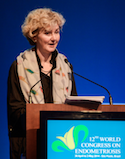The 12th World Congress on Endometriosis with 1,238 delegates from 68 countries will be a remembered as a dynamic and inspiring meeting with so many young attendees eager to share their research and learn from each other.
This was also the congress which firmly moved away from focusing on “the lesion” alone, but which addressed endometriosis from the symptoms the disease generates and how these affect the woman. The patient was very much in focus at WCE2014!
Through the Rodolphe Maheux Travel Fund WES was able to support seven young investigators in getting to Sao Paulo to present their work to this global audience.
The past and the present
WCE2014 commenced with a touching and emotional eulogy by Michel Canis to the memory of Maurice Bruhat – a visionary in gynaecologic laparoscopy. Professor Bruhat organised the 1st World Congress on Endometriosis in Clermont-Ferrand in 1986, and one could say that the roots of our society began at that very first meeting almost 30 years ago.
WES was also honoured to have the participation of Fiona Godlee, editor of the BMJ, who explained the concepts of over-diagnosis and over-treatment, presented facts in different disciplines of medicine showing that doing more does not necessarily mean doing better, and demonstrated how sub-optimal management of healthcare – not based on robust evidence of benefit and cost/effectiveness – may harm people, inflate disease mongering, and subtract resources from those who are indeed severely sick.
Her ideas are a real novelty in the field of gynaecology in general, and of endometriosis in particular.
Paolo Vercellini, now past-president of WES, emphasised the importance of the keynote lecture by Deborah Bush, Chief Executive of Endometriosis New Zealand:
“Deborah’s presentation on The patient’s role in medical decision making is the best demonstration I have ever witnessed of the importance of the input of patients for our research and clinical plans. Patients know better than doctors which are the research outcomes that really matters, and which are the clinical outcomes that are most important for them.
Patients’ preferences must guide our activity and the shared decision-making after detailed and transparent information must be the only acceptable paradigm also in the endometriosis field”, said Vercellini.
The future
Looking to the future, current WES President, Linda Giudice, could not disguise her enthusiasm for the keynote lecture by Stacey Missmer, who presented the first global collaboration in the field of endometriosis to harmonise standard operating procedures in the collection of biospecimens and clinical data (WERF EPHect):
“This work, undertaken by 54 collaborators from 16 countries, is nothing less than outstanding. By developing – and ultimately using – standard tools in collecting biospecimens and clinical data we will, for the first time, be able to collaborate across centres, pool data, and work in a concerted effort to obtain detailed clinical data from women with endometriosis and controls.
This will allow collaborative phenotyping (and sub-phenotyping) discovery and validation analyses for the very first time.
Through WERF EPHect we stand a real chance to discover the different “sub-phenomes” in endometriosis, which will enable the development of targeted treatments for the different types of diseases in endometriosis.
I encourage every single centre that is serious about research in endometriosis to adapt these protocols”, said Giudice.

WCE2014 President, Mauricio Abrao, at the Closing Ceremony of the 12th World Congress on Endometriosis
In his closing remarks, WCE2014 President Mauricio Abrao highlighted how, over four intense days with 211 presentations and 273 posters, our knowledge was improved on immunology, genetics, oxidative stress, and stem cells which may direct future development of new treatments.
For the first time at a world congress, we also specifically focused on adenomyosis and its relevance to the understanding of endometriosis.
Of particular highlight was the keynote lecture by Ivo Brosens on “Maternal pregnancy hormones and endometriosis” in which Professor Brosens called for getting to the roots of endometriosis.
During the closing ceremony, Mauricio Abrao and Linda Giudice both paid tribute to those who were shortlisted for (and those who won) the prizes for the best video, clinical, and scientific presentations. Keep up the good work — you are the future of endometriosis!
In conclusion, we may have learnt a lot since that first meeting in Clermont-Ferrand 28 years ago, but let’s heed, and never forget, the visions of Professors Bruhat and Brosens: to continue to advance our field without losing sight of the roots of endometriosis.
There is work still to be done!





